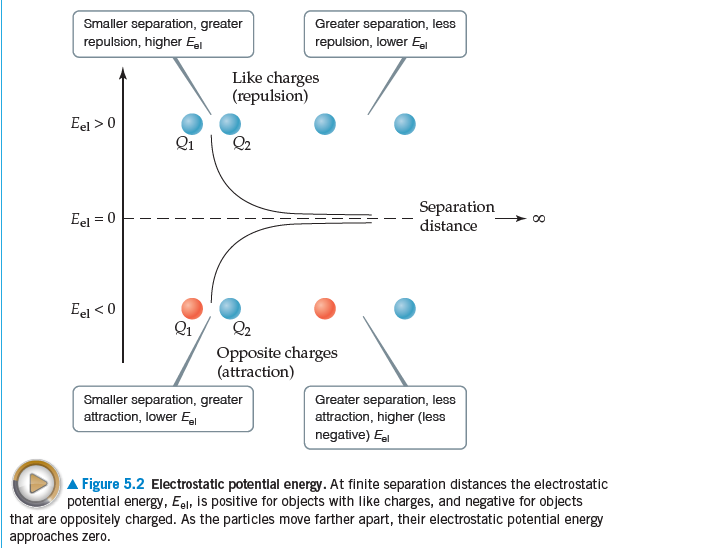Smaller separation, greater repulsion, higher El Greater separation, less repulsion, lower E Like charges (repulsion) Eel >0 Qi Q2 Separation distance Eel = 0 Eel < 0 Qi Opposite charges (attraction) Smaller separation, greater attraction, lower E Greater separation, less attraction, higher (less negative) Eal A Figure 5.2 Electrostatic potentlal energy. At finite separation distances the electrostatic potential energy, Eel, is positive for objects with like charges, and negative for objects that are oppositely charged. As the particles move farther apart, their electrostatic potential energy approaches zero. 8
Smaller separation, greater repulsion, higher El Greater separation, less repulsion, lower E Like charges (repulsion) Eel >0 Qi Q2 Separation distance Eel = 0 Eel < 0 Qi Opposite charges (attraction) Smaller separation, greater attraction, lower E Greater separation, less attraction, higher (less negative) Eal A Figure 5.2 Electrostatic potentlal energy. At finite separation distances the electrostatic potential energy, Eel, is positive for objects with like charges, and negative for objects that are oppositely charged. As the particles move farther apart, their electrostatic potential energy approaches zero. 8
Principles of Instrumental Analysis
7th Edition
ISBN:9781305577213
Author:Douglas A. Skoog, F. James Holler, Stanley R. Crouch
Publisher:Douglas A. Skoog, F. James Holler, Stanley R. Crouch
Chapter6: An Introduction To Spectrometric Methods
Section: Chapter Questions
Problem 6.19QAP
Related questions
Question
A positively charged particle and a negatively charged particle
are initially far apart. What happens to their electrostatic
potential energy as they are brought closer together?

Transcribed Image Text:Smaller separation, greater
repulsion, higher El
Greater separation, less
repulsion, lower E
Like charges
(repulsion)
Eel >0
Qi
Q2
Separation
distance
Eel = 0
Eel < 0
Qi
Opposite charges
(attraction)
Smaller separation, greater
attraction, lower E
Greater separation, less
attraction, higher (less
negative) Eal
A Figure 5.2 Electrostatic potentlal energy. At finite separation distances the electrostatic
potential energy, Eel, is positive for objects with like charges, and negative for objects
that are oppositely charged. As the particles move farther apart, their electrostatic potential energy
approaches zero.
8
Expert Solution
This question has been solved!
Explore an expertly crafted, step-by-step solution for a thorough understanding of key concepts.
This is a popular solution!
Trending now
This is a popular solution!
Step by step
Solved in 2 steps

Knowledge Booster
Learn more about
Need a deep-dive on the concept behind this application? Look no further. Learn more about this topic, chemistry and related others by exploring similar questions and additional content below.Recommended textbooks for you

Principles of Instrumental Analysis
Chemistry
ISBN:
9781305577213
Author:
Douglas A. Skoog, F. James Holler, Stanley R. Crouch
Publisher:
Cengage Learning


Principles of Modern Chemistry
Chemistry
ISBN:
9781305079113
Author:
David W. Oxtoby, H. Pat Gillis, Laurie J. Butler
Publisher:
Cengage Learning

Principles of Instrumental Analysis
Chemistry
ISBN:
9781305577213
Author:
Douglas A. Skoog, F. James Holler, Stanley R. Crouch
Publisher:
Cengage Learning


Principles of Modern Chemistry
Chemistry
ISBN:
9781305079113
Author:
David W. Oxtoby, H. Pat Gillis, Laurie J. Butler
Publisher:
Cengage Learning

Physical Chemistry
Chemistry
ISBN:
9781133958437
Author:
Ball, David W. (david Warren), BAER, Tomas
Publisher:
Wadsworth Cengage Learning,